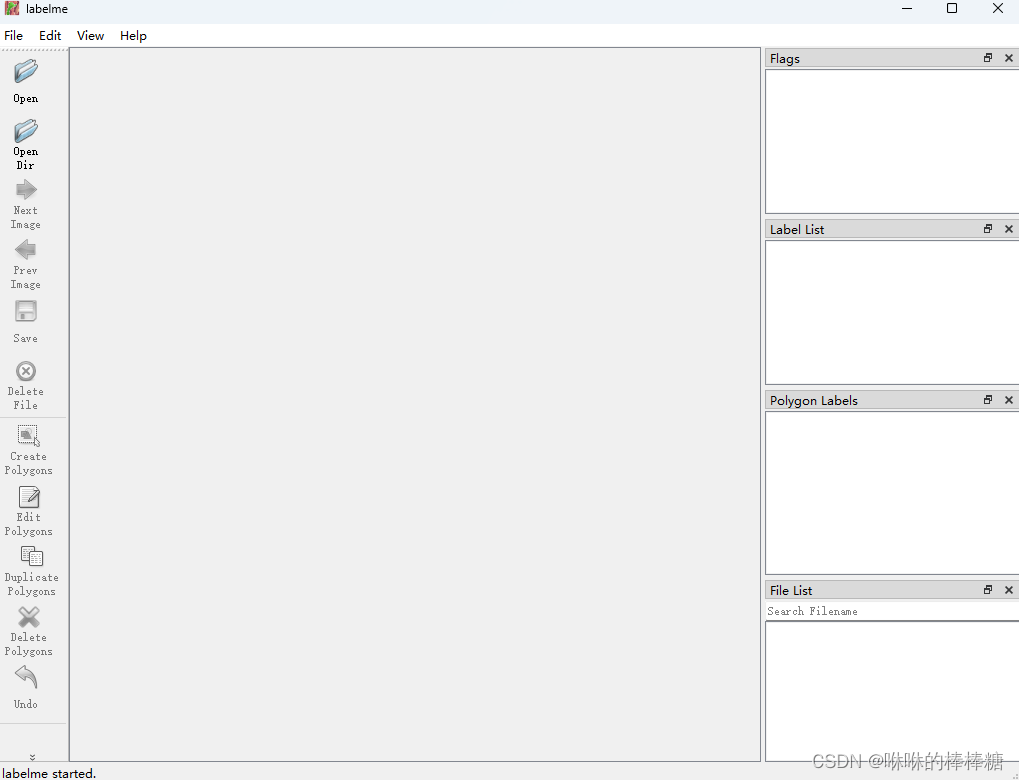第一步 收集图片
按照自己喜欢的方式收集图片,我是做的火灾检测方面,所有收集的都是火灾图片。整理图片,收集的图片进行预处理。
image
train--- 训练集
test--- 测试集
val--- 验证集
第二步 打标签
使用熟悉的标注方式标注图片,如可使用LabelMe批量打开图片文件夹的图片,进行标注并保存为json文件。
conda create -n labelme python=3.X 创建新环境
activate labelme 进入labelme环境
pip install labelme 安装labelme
labelme 启动labelme

点击Open Dir 打开数据集文件夹 进行标注图片 后点击save 即生成.json文件 保存到文件夹内
![]()
第三步 转换为coco格式
将LabelMe格式的标注文件转换成COCO标注格式,可以使用如下代码:
import json
import numpy as np
import glob
import PIL.Image
from PIL import ImageDraw
from shapely.geometry import Polygon
class labelme2coco(object):
def __init__(self, labelme_json=[], save_json_path='./new.json'):
'''
:param labelme_json: 所有labelme的json文件路径组成的列表
:param save_json_path: json保存位置
'''
self.labelme_json = labelme_json
self.save_json_path = save_json_path
self.annotations = []
self.images = []
self.categories = [{'supercategory': None, 'id': 1, 'name': 'fire'}] # 指定标注的类别
self.label = []
self.annID = 1
self.height = 0
self.width = 0
self.save_json()
# 定义读取图像标注信息的方法
def image(self, data, num):
image = {}
height = data['imageHeight']
width = data['imageWidth']
image['height'] = height
image['width'] = width
image['id'] = num + 1
image['file_name'] = data['imagePath'].split('/')[-1]
self.height = height
self.width = width
return image
# 定义数据转换方法
def data_transfer(self):
for num, json_file in enumerate(self.labelme_json):
with open(json_file, 'r') as fp:
data = json.load(fp) # 加载json文件
self.images.append(self.image(data, num)) # 读取所有图像标注信息并加入images数组
for shapes in data['shapes']:
label = shapes['label']
points = shapes['points']
shape_type = shapes['shape_type']
if shape_type == 'rectangle':
points = [points[0],[points[0][0],points[1][1]],points[1],[points[1][0],points[0][1]]]
self.annotations.append(self.annotation(points, label, num)) # 读取所有检测框标注信息并加入annotations数组
self.annID += 1
print(self.annotations)
# 定义读取检测框标注信息的方法
def annotation(self, points, label, num):
annotation = {}
annotation['segmentation'] = [list(np.asarray(points).flatten())]
poly = Polygon(points)
area_ = round(poly.area, 6)
annotation['area'] = area_
annotation['iscrowd'] = 0
annotation['image_id'] = num + 1
annotation['bbox'] = list(map(float, self.getbbox(points)))
annotation['category_id'] = self.getcatid(label)
annotation['id'] = self.annID
return annotation
# 定义读取检测框的类别信息的方法
def getcatid(self, label):
for categorie in self.categories:
if label == categorie['name']:
return categorie['id']
return -1
def getbbox(self, points):
polygons = points
mask = self.polygons_to_mask([self.height, self.width], polygons)
return self.mask2box(mask)
def mask2box(self, mask):
'''从mask反算出其边框
mask:[h,w] 0、1组成的图片
1对应对象,只需计算1对应的行列号(左上角行列号,右下角行列号,就可以算出其边框)
'''
# np.where(mask==1)
index = np.argwhere(mask == 1)
rows = index[:, 0]
clos = index[:, 1]
# 解析左上角行列号
left_top_r = np.min(rows) # y
left_top_c = np.min(clos) # x
# 解析右下角行列号
right_bottom_r = np.max(rows)
right_bottom_c = np.max(clos)
return [left_top_c, left_top_r, right_bottom_c - left_top_c,
right_bottom_r - left_top_r] # [x1,y1,w,h] 对应COCO的bbox格式
def polygons_to_mask(self, img_shape, polygons):
mask = np.zeros(img_shape, dtype=np.uint8)
mask = PIL.Image.fromarray(mask)
xy = list(map(tuple, polygons))
PIL.ImageDraw.Draw(mask).polygon(xy=xy, outline=1, fill=1)
mask = np.array(mask, dtype=bool)
return mask
def data2coco(self):
data_coco = {}
data_coco['images'] = self.images
data_coco['categories'] = self.categories
data_coco['annotations'] = self.annotations
return data_coco
def save_json(self):
self.data_transfer()
self.data_coco = self.data2coco()
# 保存json文件
json.dump(self.data_coco, open(self.save_json_path, 'w'), indent=4) # 写入指定路径的json文件,indent=4 更加美观显示
labelme_json = glob.glob('./json/*.json') # 获取指定目录下的json格式的文件
labelme2coco(labelme_json, './intances_train2017.json') # 指定生成文件路径如图所示:打好标签的.json文件放在了json文件夹里,倒数第二行路径就写./json
labelme_json = glob.glob('./json/*.json') # 获取指定目录下的json格式的文件第四步 整理数据

最后整理数据,由于我的程序是需要和coco数据集命名一致,最好就命名一致。
这里只做了训练集和验证机的annotations 。
最终应该格式如下
coco
-annotations
---instances_train2017
---instances_val2017
-train2017
-val2017
-test2017




















 862
862

 被折叠的 条评论
为什么被折叠?
被折叠的 条评论
为什么被折叠?








